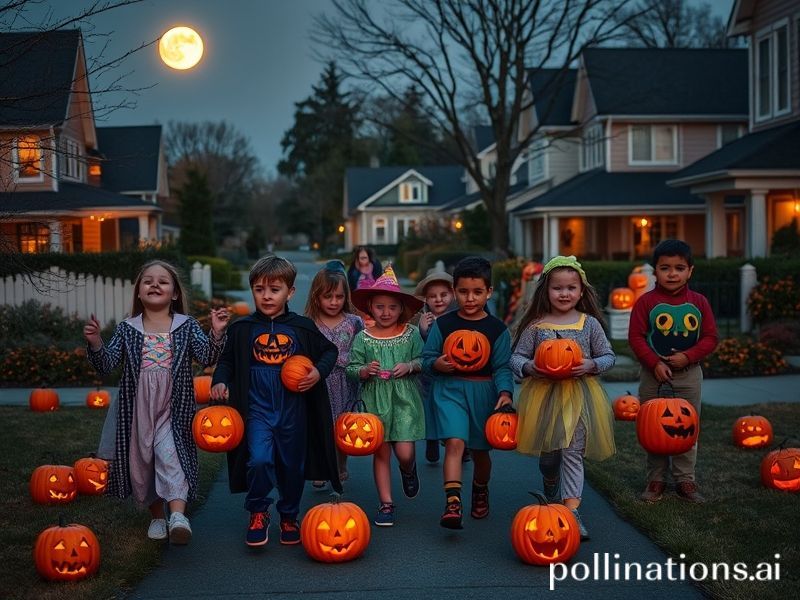trick or treat
**Title: “Trick or Treat: The Sweet, Spooky Global Takeover You Didn’t See Coming”**
Alright, folks, grab your candy stashes and let’s dive into the global phenomenon that’s got the world saying “trick or treat” in more languages than you can shake a plastic pumpkin at. Yes, we’re talking about the sweet, spooky spectacle that is Halloween, and its delightful little sidekick, trick or treating. But why is this tradition trending globally, and what’s the big deal? Let’s break it down.
**Cultural Context: From Ancient Roots to Global Streets**
Trick or treating, as we know it, is a relatively modern invention, but its roots dig deep into ancient Celtic and Christian traditions. The Celts celebrated Samhain, a festival marking the end of harvest and the beginning of winter, believing that the boundary between the worlds of the living and the dead became blurred. Fast forward to the 19th and 20th centuries, and you’ve got Irish and Scottish immigrants bringing their Halloween traditions to North America, where trick or treating as we know it began to take shape.
But here’s the kicker: what started as a North American tradition has since morphed into a global spectacle. From Japan’s “Kawaii” Halloween in Tokyo to Mexico’s Día de los Muertos (Day of the Dead), which has seen a surge in popularity thanks to, yes, you guessed it, the internet and pop culture.
**Social Impact: More Than Just Candy**
So, why is trick or treating trending globally? For starters, it’s a freaking blast. Who doesn’t love dressing up in costumes, eating copious amounts of candy, and pretending it’s socially acceptable to knock on strangers’ doors and demand sugar? But beyond the fun, there’s a deeper social impact.
Trick or treating fosters community engagement and neighborly interactions. In an age where we’re more connected digitally than ever but often feel isolated, Halloween offers a chance to, quite literally, open your door to your community. Plus, it’s an opportunity for kids to practice social skills, from saying “trick or treat” to expressing gratitude (hopefully).
And let’s not forget the economic impact. Halloween is big business, with global spending expected to reach over $10 billion in 2023. From costumes to decorations, candy to themed parties, the economic ripple effect is undeniable.
**The Global Appeal: Why It’s Significant**
But what makes trick or treating so universally appealing? For one, it’s adaptable. Cultures around the world have embraced and reimagined Halloween, blending it with their own traditions and creating unique celebrations. Take China, for example, where Halloween is still relatively new but gaining traction, especially among younger generations eager to participate in global trends.
Moreover, trick or treating taps into something primal and universal: the love of play, the thrill of dressing up, and the joy of receiving treats (or, in some cases, playing tricks). It’s a celebration that transcends language and cultural barriers, bringing people together in a shared experience.
**The Internet’s Role: Fueling the Trend**
Of course, we can’t ignore the internet’s role in fueling this global trend. Social media platforms are awash with Halloween content, from DIY costume tutorials to elaborate home decorations. Viral trends like the “Harvest Spooktacular” challenge on TikTok have further cemented Halloween’s place in global pop culture.
Plus, the internet has made it easier than ever to share and adapt traditions. What starts as a trick or treating tradition in the U.S. can be seen, shared, and reimagined by someone in Australia, Brazil, or anywhere else with an internet connection.
**Conclusion: The Sweet, Spooky Future**
So, what’s next for trick or treating? As it continues to trend globally, we can expect even more creativity and adaptation. From virtual trick or treating events to eco-friendly, sustainable celebrations, the future of Halloween is as bright (and spooky) as ever.
But perhaps the most significant aspect of trick or treating’s global trend is its ability to bring people together. In a world that often feels divided, Halloween offers a chance to connect, to celebrate, and to indulge in a little sweet, spooky fun. And really, what’s not to love about that?
—
**







